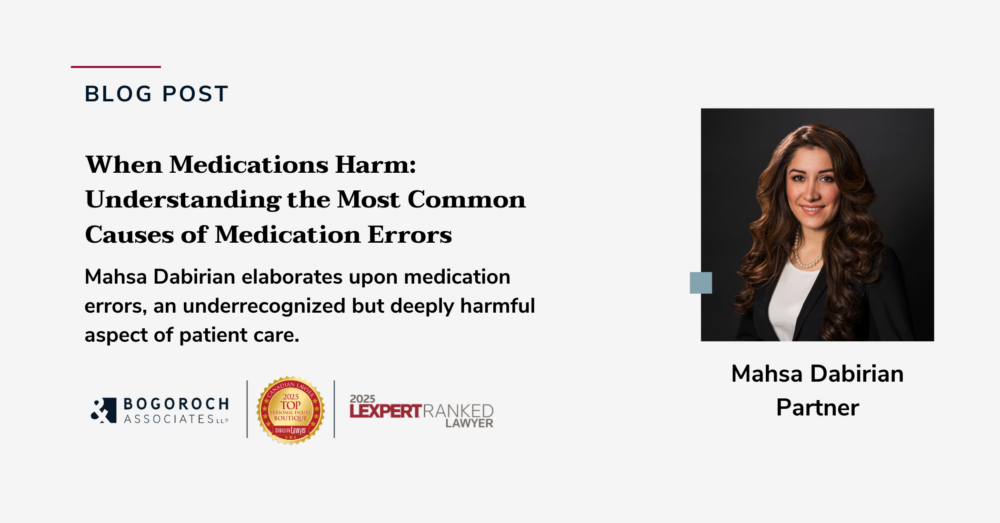
Medication errors are an underrecognized but deeply harmful aspect of patient care. They account for thousands of injuries, hospitalizations, and even deaths each year in Canada. From prescribing the wrong dosage to administering a drug via the incorrect route, these errors are often preventable—and when they occur, the consequences can be catastrophic.
At Bogoroch & Associates LLP, we have represented numerous individuals and families harmed by negligent medical care, including cases involving medication errors. We know that behind every error is a person who deserves answers—and often, accountability.
What Are Medication Errors?
A medication error is defined by the Academy of Managed Care Pharmacy (AMCP) as a “preventable event that may cause or lead to inappropriate medication use or patient harm.” These mistakes can occur at any stage of the medication use process—before the patient even receives the drug, and long after it has been prescribed.
Where Errors Can Occur:
- Prescribing Stage: Errors in drug choice, dose, frequency, or duration. These often stem from misdiagnoses or a failure to review the patient’s full medical history.
- Transcribing: Mistakes occur when handwritten prescriptions are entered incorrectly into electronic systems, especially when abbreviations or illegible handwriting are involved.
- Dispensing: Pharmacists may mislabel drugs or dispense the wrong medication or strength, particularly when faced with look-alike or sound-alike names.
- Administering: Nurses or caregivers might deliver the wrong drug, wrong dose, or via the wrong route—sometimes due to distraction, fatigue, or communication failures.
- Monitoring: Failure to observe for adverse effects, drug interactions, or necessary lab work can allow harm to progress unnoticed.
Each step introduces potential failure points—and without adequate systems and communication, errors can slip through the cracks.
Common Types of Medication Errors
Understanding the specific types of medication errors helps clarify where risk lies:
- Wrong Dose or Strength: This is one of the most frequent and dangerous types of errors. A slight miscalculation in pediatric or geriatric dosing can have life-threatening consequences. Errors can stem from misreading units (e.g., mg vs. mcg) or incorrect weight-based calculations.
- Wrong Medication: This often occurs due to look-alike/sound-alike drug names (e.g., Zantac vs. Zyrtec). A similar appearance of packaging or drug names can easily cause selection mistakes—especially in fast-paced environments or when using dropdown menus in digital prescribing tools.
- Incorrect Route of Administration: Administering a medication via the wrong route—oral instead of intravenous, for instance—can change the drug’s bioavailability, causing it to act too slowly or too intensely, and potentially resulting in severe patient harm.
Root Causes of Medication Errors
While individual negligence may play a role, most medication errors stem from systemic problems and communication breakdowns:
- Communication Failures: Lack of clear communication among care providers—or between providers and patients—remains a major cause. This includes missed handovers during shift changes, incomplete medication histories, and failing to confirm drug allergies.
- Look-Alike, Sound-Alike Drugs: A persistent issue in both hospital and community pharmacy settings. Without additional verification systems, busy clinicians may select the wrong drug from a menu or shelf—particularly when two drugs differ by only one or two letters.
- Systemic Pressure and Overload: Emergency departments, surgical wards, and intensive care units are high-pressure environments where multitasking, fatigue, and time constraints lead to a higher likelihood of error.
Emergency rooms are well-known for medication errors because the environment itself is inherently high-risk. Critical care often requires immediate decisions. Standard protocols such as double-checking or barcode scanning may be skipped under pressure. Also, physicians and nurses in emergency departments are routinely interrupted during complex tasks. Combined with long shifts and sleep deprivation, this drastically increases the probability of a preventable error.
Prevention Strategies & Best Practices
Despite the risk, there are proven methods to prevent medication errors. Many hospitals and healthcare systems are implementing safety measures to reduce incidents:
- Use of Technology: Electronic prescribing (e-prescribing), computer physician order entry (CPOE), and barcode medication administration systems reduce transcription and dispensing errors by cross-checking entries with standardized databases.
- Double-Checking Protocols: Many institutions have adopted mandatory verification processes for high-risk medications. These include checklists, independent verification by a second clinician, and clear labelling of syringes and IV lines.
- Education and Ongoing Training: Routine training sessions for staff regarding new medications, updated protocols, and known error patterns are vital. Nurses and pharmacists who are aware of the most commonly confused medications are better equipped to flag potential issues.
Nonetheless, the existence of prevention tools is meaningless unless they are implemented consistently and monitored for effectiveness. When systems fail—and they often do—the consequences fall on patients.
How Bogoroch Medical Malpractice Lawyers Can Help
If you or a loved one has suffered because of a medication error, it could be the result of medical negligence. At Bogoroch & Associates LLP, we help victims of medication errors navigate the complex intersection of medicine and law. Our legal team has extensive experience in uncovering:
- Inadequate protocols or systems
- Negligent prescribing or administration
- Failure to monitor or respond to adverse effects
- Communication breakdowns between providers
We understand the physical, emotional, and financial toll of such incidents. Our team will help you pursue compensation for:
- Pain, suffering, and loss of enjoyment of life
- Lost wages and diminished earning capacity
- Additional medical treatment
- Long-term rehabilitation or home care
- Out-of-pocket expenses
We are committed to access to justice and excellence in advocacy. We serve clients across Ontario and have a proven track record of success in medical negligence cases.